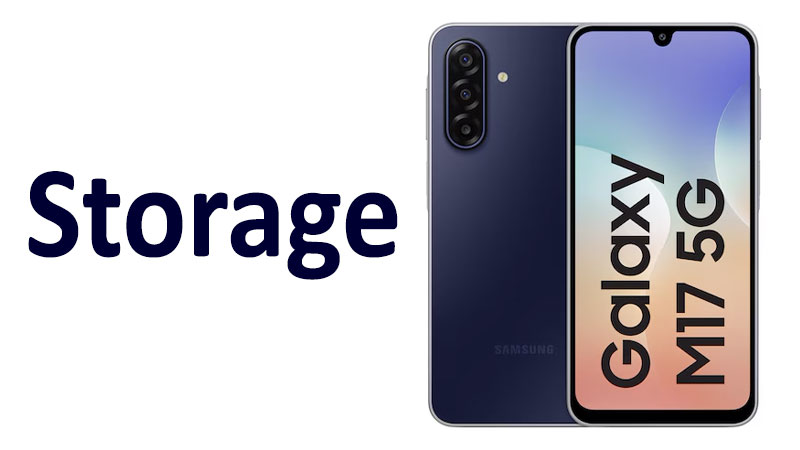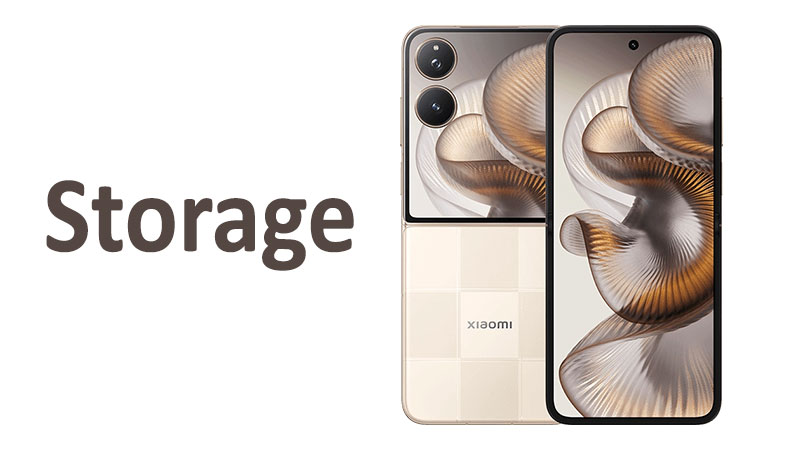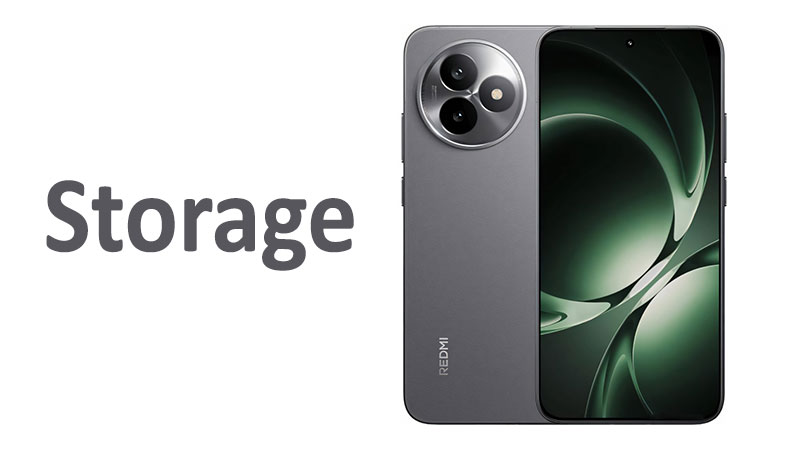The Samsung Galaxy M17 Storage feature is a vital component for any modern user. Understanding its capacity and type is essential before making a purchase decision. The storage configuration directly impacts the phone’s performance and long-term usability. This comprehensive guide explores all aspects of the M17’s internal storage and expandability. We will examine the technology behind the drive. Furthermore, we provide a detailed buyer’s guide to help you maximize your device’s potential.
Understanding the Samsung Galaxy M17 Storage Capacity
The Samsung Galaxy M17 5G comes with a single internal storage capacity option. This crucial detail is 128GB across all variants of the phone. Whether you choose the 4GB, 6GB, or 8GB RAM model, the onboard memory remains the same. This 128GB configuration positions the M17 firmly in the mid-range segment. It meets the standard expectations of today’s smartphone users.
Is 128GB Enough for Modern Users?
For many people, 128GB offers a perfect balance of space and cost-efficiency. It provides sufficient room for numerous applications and multimedia files. You can store thousands of photos and many hours of high-definition video. The average user finds this capacity quite accommodating. However, heavy users and mobile gamers may quickly fill this space. Downloading large game titles and shooting 4K videos consume memory rapidly. The actual usable space is also lower than the advertised 128GB. The Android operating system and Samsung’s One UI skin occupy a significant portion. Users typically get around 105GB to 115GB of accessible storage out of the box.
The Rise of 128GB as a Standard
Smartphones across the industry now widely adopt 128GB as the base storage option. This move reflects the growing size of applications and media files. Just a few years ago, 64GB was the standard base level. Samsung has appropriately moved the M-series up to this current standard. This change provides a better long-term experience for budget-conscious consumers. It ensures the phone remains usable for several years.
The Performance Factor: UFS 2.2 Storage Type
The capacity of the storage is only one part of the equation. The speed of the memory technology is equally critical for performance. The Samsung Galaxy M17 utilizes Universal Flash Storage (UFS) 2.2 technology. This choice offers substantial performance benefits over older standards. It is far superior to the embedded MultiMediaCard (eMMC) standard.
What is UFS 2.2?
UFS is a modern storage standard designed for high-performance mobile devices. UFS 2.2 is an advanced version of this technology. It delivers significantly faster read and write speeds than eMMC. This speed is vital for many common smartphone tasks. The M17 uses this technology to ensure quick and efficient data handling.
Real-World Impact of UFS 2.2 Speed
The faster speeds of UFS 2.2 translate directly to a better user experience. Applications launch almost instantaneously. Large files, such as movies or game updates, download and install much quicker. The system boot-up time is also reduced significantly. Furthermore, multitasking becomes smoother. The phone can swap data between the RAM and storage at a faster rate. This prevents noticeable lag or stuttering during intensive use. Users will appreciate the responsiveness when loading heavy games. Video editing or batch photo processing also benefit greatly from this speed.
Specialized Comparison: UFS 2.2 vs. eMMC
Many older or lower-end budget phones still use the eMMC standard. The difference in performance between UFS 2.2 and eMMC is substantial. UFS 2.2 offers sequential read speeds that can be three times faster. Write speeds show an even greater improvement in many benchmarks. Crucially, UFS is also capable of simultaneous read and write operations. The older eMMC standard cannot manage this concurrency efficiently. The M17’s use of UFS 2.2 guarantees a modern, fluid performance feel. This is a major advantage in the competitive budget segment.
The Flexibility of Expandable Storage
While the 128GB internal capacity is fixed, the Samsung Galaxy M17 provides expansion options. The device supports external memory via a microSDXC card slot. This feature gives users immense flexibility for storing large media libraries. The M17 supports cards up to a massive 2TB.
The Hybrid SIM Slot Consideration
It is important to note that the M17 uses a hybrid dual-SIM tray. This design means the second slot can hold either a second Nano-SIM card or a microSDXC card. Users must choose between dual network connectivity or memory expansion. This common design choice forces a crucial decision for many potential buyers. If you rely on two phone numbers, you cannot expand the storage. Conversely, if you need more than 128GB, you must use only one SIM card.
Benefits of MicroSD Expansion
The ability to expand storage up to 2TB is a huge advantage. It provides virtually limitless space for non-app data. You can keep all your photos, videos, and music on the microSD card. This practice keeps the faster internal UFS 2.2 storage free for apps and system files. Using external storage offers a cost-effective way to manage large media collections. MicroSD cards are often inexpensive and easily interchangeable. This feature appeals greatly to content creators and media enthusiasts.
Choosing the Right MicroSD Card
To match the phone’s internal speed, buyers should select a high-speed microSD card. Look for cards rated as U3 and V30, or those with A2 performance ratings. These designations indicate fast read and write speeds. A slower card will bottleneck performance, especially when accessing media. Using a fast card ensures smooth 4K video recording directly to the card. It also makes loading images from the gallery much quicker. Do not compromise on speed when purchasing external memory.
Storage Configuration: Pros and Cons
The Samsung Galaxy M17’s storage setup has several clear advantages and a few notable limitations. Weighing these factors helps a buyer determine if the phone meets their needs.
Pros of M17 Storage
The UFS 2.2 technology provides a significant speed boost over older phones. This results in fast app loading and excellent overall responsiveness. The standard 128GB internal storage is a generous baseline capacity. It suits most average users without needing immediate expansion. The ability to expand storage up to 2TB is massive. It gives power users and content creators a scalable memory solution. This combination of fast internal storage and large external potential is very strong.
Cons of M17 Storage
The lack of a 256GB internal storage option is a minor drawback. Some power users prefer a larger integrated capacity without relying on external cards. The hybrid SIM slot design presents a challenge. Users must sacrifice a second SIM card for memory expansion. This limits flexibility for those needing both dual-SIM functionality and extra space. While UFS 2.2 is fast, it is not the latest standard. Newer high-end phones utilize UFS 3.1 or UFS 4.0, which are even faster. This is an understandable compromise for a budget-friendly device, however.
Specialized Comparison with Competitors
It is useful to compare the M17’s storage against key models in the same segment. We will look at its predecessor, the Galaxy M16 5G, and a strong competitor, the Redmi 12 5G. This comparison highlights where the M17 stands in the marketplace.
Comparison with the Galaxy M16 5G
The Samsung Galaxy M16 5G also offered 128GB as its base internal storage. Storage type data for the M16 can vary, but most M-series phones around that generation used UFS 2.2. The M17 continues this trend, confirming Samsung’s commitment to the UFS standard. The main improvement is consistency across the M-series lineup. The M17 ensures that budget users do not get stuck with outdated eMMC speeds. This guarantees a consistent performance leap from older, slower budget devices.
Comparison with the Redmi 12 5G
The direct competitor, the Redmi 12 5G, also comes with 128GB storage options. It also uses the UFS 2.2 storage type. In this regard, the two phones are evenly matched on speed and base capacity. The competition is tight in the sub-$200 segment. Manufacturers must include fast storage to remain competitive. The M17 differentiates itself with other features, such as its Super AMOLED display. When comparing storage alone, both devices offer a similar, high-speed experience. The buyer’s choice will depend on brand preference and other features.
Storage Management: A Comprehensive Buyer’s Guide
A smart storage strategy is vital for long-term satisfaction with the M17. Here are essential tips for different user types considering the M17.
Tips for the Light User
Light users typically stick to basic apps and minimal photography. Social media, web browsing, and messaging define their usage. The 128GB internal storage will be more than enough for them. They do not need to worry about purchasing an external memory card. These users can freely use the phone’s dual-SIM capability. Their focus should be on regularly clearing app caches to maintain optimal speed. They should delete unnecessary temporary files occasionally.
Strategies for the Moderate User
Moderate users download several games and stream music and video frequently. They take many photos but do not shoot extensive 4K video. The 128GB internal storage will serve them well initially. However, they should consider cloud storage for photos and videos. Services like Google Photos or OneDrive can save valuable internal space. If they need to use the second SIM slot, cloud storage becomes a necessity. They can download media files only when needed, minimizing local storage consumption.
Solutions for the Heavy User and Content Creator
Heavy users are mobile gamers, videographers, and large media consumers. They will quickly exhaust the 128GB internal storage. These users absolutely require a microSDXC card for expansion. They should purchase a high-speed card with a minimum of 256GB, ideally 512GB or more. A high-capacity card ensures room for continuous 4K video recording.
They must also implement a strict storage management plan. They should move all media files to the external card immediately upon creation. Applications must remain on the internal UFS 2.2 memory for the best performance. Users need to be mindful of the hybrid slot limitation. They must decide if two SIM cards are more important than 2TB of expansion. This choice is critical for their daily use.
Optimizing Internal UFS 2.2 Storage
Users should always prioritize the internal UFS 2.2 storage for performance-critical data. This includes the operating system, core applications, and essential system files. Faster internal memory improves app launch times dramatically. Moving large, non-essential files, like saved podcasts or bulk photos, off the internal drive is smart. Utilize the microSD card for these less frequently accessed files. This division maintains the phone’s snappiness and responsiveness.
Understanding Long-Term Software Updates
The M17 is noteworthy for Samsung’s promise of long-term software support. This commitment includes six years of updates. The storage quality is critical in this context. A high-quality UFS 2.2 chip ensures the phone can handle future, larger operating system updates. Slower storage often struggles with new features and performance demands. The fast, robust storage supports the longevity of the software commitment. This feature adds significant value to the M17 as a long-term investment. Buyers get a phone that will run smoothly for many years.
Advanced Considerations for Buyers
Beyond capacity and type, several advanced storage considerations affect the purchase decision. These factors involve data security, format standards, and overall system integration.
Storage and System Integration
The Galaxy M17 runs on the Exynos 1330 chipset and One UI 7 based on Android 15. The UFS 2.2 storage is expertly integrated with this hardware and software. Samsung optimizes its One UI to leverage the UFS speed. This tight integration ensures efficient data flow across the phone’s components. Poor integration, often seen in lower-quality devices, leads to system bottlenecks. The M17 avoids these issues with high-quality, Samsung-designed components. The resulting experience is reliable and free from frustrating slowdowns.
Data Security and Storage
The M17 includes Samsung Knox Vault for enhanced security. This feature protects sensitive data, including passwords and biometrics. The physical storage medium plays a role in this security. The robust nature of UFS flash memory helps ensure data integrity. While Knox is a software and hardware solution, it relies on reliable storage. Users can trust the M17’s storage to safeguard their most important information. Security-conscious buyers should consider this a major positive factor.
The Role of RAM and Storage Interplay
The M17 comes in 4GB, 6GB, and 8GB RAM variants. Random Access Memory (RAM) and internal storage work together closely. RAM handles actively running programs and data. Storage holds data when the phone is off or when programs are idle. When RAM gets full, the phone uses the storage as temporary overflow memory, known as swap space. Faster storage, like UFS 2.2, makes this swapping process quick. This prevents performance dips when running many applications simultaneously. Buyers should match their RAM choice to their usage. However, the UFS 2.2 storage ensures the system remains responsive even with heavy loads. The 8GB RAM variant combined with UFS 2.2 offers the best multitasking experience.
Final Thoughts on the M17 Storage Value
The Samsung Galaxy M17 offers a storage solution focused on value and performance. It provides the contemporary standard of 128GB capacity. The inclusion of UFS 2.2 technology guarantees high data speeds. Furthermore, the massive 2TB expandable storage offers immense media flexibility. This configuration is highly competitive within the budget 5G market segment. Buyers receive a future-proof phone with exceptional long-term usability. The M17’s storage stands out as a reliable and powerful feature. It allows users to store more and wait less.
Conclusion
The Samsung Galaxy M17 storage configuration is a key strength for this budget-friendly 5G device. Its 128GB internal capacity is the perfect modern starting point. More importantly, the use of UFS 2.2 technology ensures fast app loading and smooth performance. This speed is critical for a satisfactory smartphone experience. The 2TB microSD expansion capability offers unparalleled flexibility for media enthusiasts.
The only real trade-off is the hybrid SIM slot design. Buyers must prioritize either dual-SIM functionality or massive storage expansion. Overall, the M17 delivers exceptional storage value for its price point. It is an excellent choice for users seeking speed, capacity, and long-term relevance. The M17’s storage setup will support heavy usage for years to come.
Frequently Asked Questions (FAQ)
1. Does the Samsung Galaxy M17 5G support an external memory card?
Yes, the Samsung Galaxy M17 5G supports a microSDXC card. You can expand the storage significantly. The phone allows for expansion up to a maximum of 2TB.
2. What kind of internal storage technology does the M17 use?
The Samsung Galaxy M17 uses Universal Flash Storage (UFS) 2.2 technology. This provides fast data transfer speeds. UFS 2.2 is much quicker than the older eMMC standard.
3. How much of the 128GB storage is actually usable?
The full 128GB is the raw capacity of the chip. The operating system and pre-installed apps take up some space. Users can expect approximately 105GB to 115GB of accessible storage initially.
4. Is the microSD card slot a dedicated slot or a hybrid one?
The Galaxy M17 features a hybrid SIM slot. This means the second slot holds either a Nano-SIM card or a microSD card. You cannot use both simultaneously.
5. Why is UFS 2.2 important for a mid-range phone like the M17?
UFS 2.2 ensures faster loading times for all applications and games. It also speeds up file transfers and system boot-up. This technology maintains the phone’s responsiveness over time.



